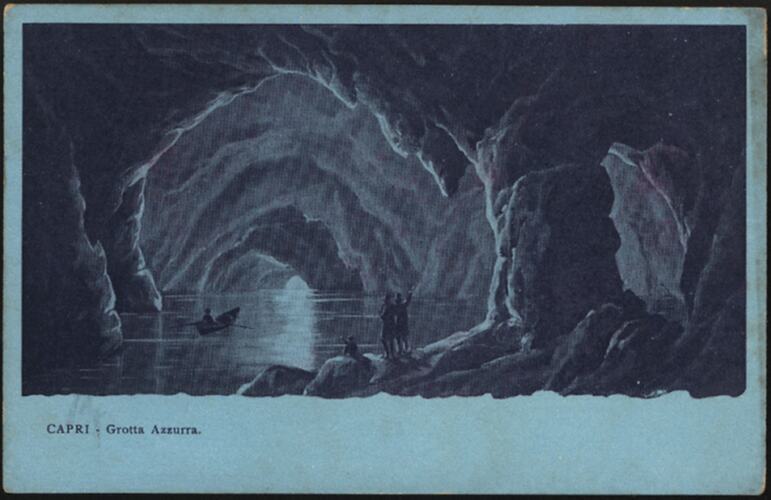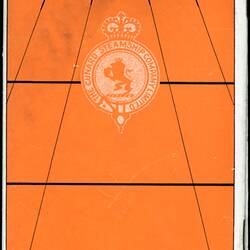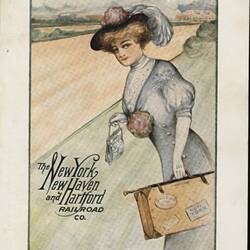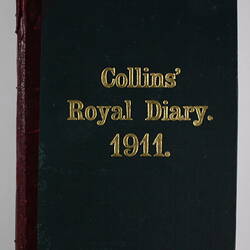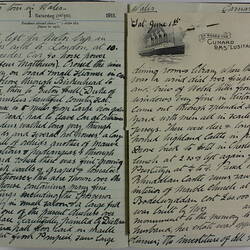Summary
Postcard of the Grotta Azzura on the island of Capri, Italy,1911.
This is one of about eighty travel brochures, maps, railway timetables, postcards and guidebooks collected by Miss Olive Oliver during her round-the-world tour of the United States of America, Britain and Europe in 1911. Olive was a wealthy 32 year old woman from Melbourne and she travelled with her father, William Oliver, her brother, William Donald ('Don'), and her friend, Gretta Nicolls. Olive was born in Armadale, Melbourne in 1879 and died there in 1961. She did not marry or have any children.
During the year long round-the-world tour, Olive travelled to many places in the USA, stayed for a period in London, motored through Wales and Scotland, and visited many of Europe's major cities. Many of the objects that Olive collected relate to USA destinations such as Honolulu, Seattle, Yosemite National Park, Monterey, California, Niagara Falls, and New York, while others relate to British towns and cities including Edinburgh and London. Olive and her companions travelled by train, motor car and ship, including the Royal Mail Line S.S. Makura, the Cunard Line RMS Lusitania (later famously torpedoed and sunk by a German U-boat on in 1915 during World War One), and the Orient Line S.S. Osterley.
During this era the world was opening up to the independent or 'New Woman', with many women being granted new economic and legal rights. There were unheralded opportunities for travel and recreation, as well as work, particularly for middle- and upper-class women. Many of the travel brochures, guidebooks and postcards that Olive collected were clearly aiming at attracting women tourists and feature prominent illustrations of women at play.
Significance
Olive Oliver Collection - The sea chest, diaries, travel brochures, guidebooks, maps, postcards and other ephemera in this small collection document Miss Olive Oliver's international travel experience as a wealthy, unmarried Australian woman in the early 20th century, and taps into issues of gender and national identity.
During the first few decades of the 20th century, the world was opening up to the independent or 'New Woman', with many women being granted new economic and legal rights. There were unheralded opportunities for travel and recreation, as well as work, particularly for middle- and upper- class women. In light of this, the collection in general highlights the types of recreational activities popular at the time for wealthy women tourists, such as shopping, socialising, dining and sightseeing. In particular, Olive Oliver's diary also provides fascinating insights into her own particular holiday choices and experiences, and her selection of ephemera souvenirs evocatively highlights her itinerary. The changing role of women in society is evident in the key role that women play in the graphic design of the travel ephemera and postcards in this collection, as well as in the content of some of it. For instance, Miss Oliver was tapping into contemporary popular culture relating to women's emancipation as she travelled around the world. This is particularly evident in some of the postcards that she collected featuring women at work at a major insurance company in New York.
More than just an insight into women's travel and a record of one particular person's holiday, however, the collection is also a signifier of place and national identity in early 20th century Australia. Being located a long way from much of the rest of the world, Australians have long had an interest in travel outside their own national and state borders, and this collection is a reminder of this interest. The collection highlights the importance of travel in the lives of Australians who had immigrated from places such as Britain and Europe. Although Australia's own local tourism industry was expanding in the early 20th century, there was still a strong lure to return 'home' to the 'old world'. There was also a strongly held attraction for the 'grand tour' to Britain and Europe, and trips to new world countries such as America, to expand the cultural education of Australians. The emphasis on travel to countries from which new Australian settlers were traditionally drawn highlights the cultural outlook and identity that Australians engaged with at this time, which was typically British and Eurocentric. This outlook and world-view has persisted from the days of settlement through to recent decades, when it shifted somewhat as interest in travel to our Asian neighbours developed and the origins of immigrants became broader.
Finally, the survival of this collection for almost a century until its acquisition by the Museum highlights the importance that this international tour had in Miss Oliver's life, and the collection will be a remarkable resource for better understanding early 20th century travel.
More Information
-
Collection Names
-
Collecting Areas
-
Acquisition Information
Donation from Lois Comeadow, Dec 2009
-
User
-
Inscriptions
Text, CAPRI - Grotta Azzura.
-
Classification
-
Category
-
Discipline
-
Type of item
-
Overall Dimensions
142 mm (Width), 91 mm (Height)
-
References
State Library of Victoria, [Link 1]*&CNT=15, accessed 16/07/09 Southern Pacific Historical and Technical Society, [Link 2] accessed 16/07/09 Australian National Maritime Museum, [Link 3] accessed 16/07/09 Family News and Research Data, Oliver Society, Issue No. 21, 2005, p.14 Emails from the donor. [Link 4]
-
Keywords
Holidays, Leisure, Postcards, Recreation, Souvenirs, Travel, Travel & Tourism
